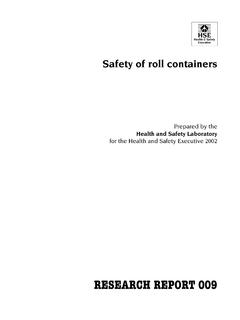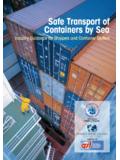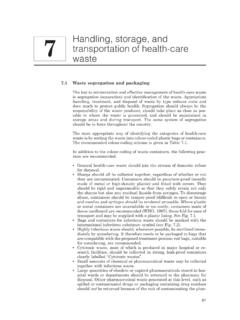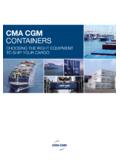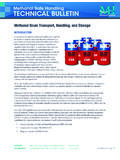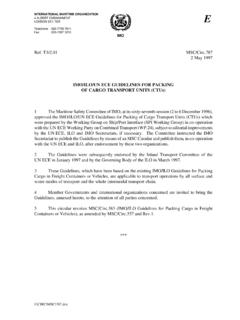Transcription of Safe Handling of - jsia.gr.jp
1 safe Handling of Hydrochloric Acid Japan Soda Industry Association Contents Introduction 1. I Information about Hydrochloric Acid 2. 1. Commercial Hydrochloric Acid 2. 2. General Characteristics of Hydrochloric Acid 3. 3. Effects of Hydrochloric Acid on the Human Body 4. II Containers for Hydrochloric Acid 5. 1. Types of Containers 5. 2. Displays on the Containers 5. III Handling of Containers 6. 1. Transportation 6. 2. Precautions for Storage 7. IV Tank Trucks, Rail Tanks, and Tankers 8. 1. Structure 8. 2. Unloading from Tank Trucks, Tank Cars, and Tankers 8. V Use of Hydrochloric Acid 10. 1. General Precautions 10. 2. Fire Precautions 11. 3. Treatment of Empty Containers and Waste 11. 4. Accident Prevention Measures 11. 5. Prevention Measures for Hygiene 12. VI Actions to be Taken in Case of a Leakage 13. VII Maintenance of the Facilities (Cleaning and Repairing) 14.
2 VIII Safety Facilities 16. IX Emergency Measures 17. 1. General Guidelines 17. 2. Skin Exposure 17. 3. Eye Exposure 17. 4. Swallowing 18. 5. Poisoning caused by Concentrated Hydrochloric Acid Mist or Hydrogen Chloride 18. X Reference Items 19. 1. Properties of Hydrochloric Acid 19. 2. Relationship between the Concentration of the Formed Hydrochloric Acid, Absorption Temperature, and the Concentration of Equilibrium Hydrochloric Acid 19. 3. Heat of Dilution of Hydrochloric Acid 20. 4. Partial Pressures of HCl and H2O on Hydrochloric Acid 21. XI Related Laws and Regulations 22. XII Cases of Disasters 24. Introduction Hydrochloric acid (excluding solutions contain- ing not more than 10% hydrogen chloride) is des- ignated as a deleterious substance under Japanese laws, and is a strongly corrosive sub- stance. Persons who handle hydrochloric acid should learn about the related laws and regula- tions (such as the Poisonous and Deleterious Substances Control Law), its properties, and pre- cautions on Handling , and should observe them to ensure safety.
3 This leaflet compiles the information that deal- ers, transpor ters, and consumers Handling hydrochloric acid need to know as a guideline for the routine prevention of accidents. 1 . I. Information about Hydrochloric Acid 1. Commercial Hydrochloric Acid Commercial hydrochloric acid normally contains 35% hydrogen chloride (38%. in special cases), and is classified into industrial, reagent, food additive, and Japanese Pharmacopoeia grades according to its uses. The qualities of these grades are specified in JSIA (Japan Soda Industry Association) Standards, JIS. (Japanese Industrial Standards), and JSFA (Japanese Standards for Food Additives) as shown in the following tables. Quality of industrial synthetic hydrochloric acid (JSIA 04-1998). Component Type 1 Type 2. Hydrochloric acid (%). 37. 35.. Iron (Fe) (%).. Residue on ignition (%).
4 Quality of reagent grade hydrochloric acid (JIS K 8180-1975). Special grade Arsenic analysis grade Residue on evapo- . ration (%). Residue on igni- . tion (sulfate) (%). Sulfate content . (SO42-) (%). Free chlorine within limits within limits (Cl . approx. ) (Cl . approx. ). Iodine-reducing within limits within limits substances ( . approx. as SO3) ( . approx. as SO3). Heavy metals (as . Pb) (%). Iron (Fe) (%) . Arsenic (As) (%) . Content (%) 2 . Quality of hydrochloric acid for food additives (JSFA-III, 1973). Appearance Colorless to light yellow Content 90 120% of indicated content 2- Sulfates w/v% as SO4.. Arsenic w/v% as As2O3.. Heavy metals w/v%.. Iron w/v%.. Residue on ignition 200 ppm . Hydrochloric acid includes by-product hydrochloric acid of various concentra- tions and accompanying components as a by-product of various chemical reac- tion processes.
5 It is important to use by-product hydrochloric acid after obtain- ing sufficient information about the components other than hydrogen chloride or other information from the manufacturer. 2. General Characteristics of Hydrochloric Acid Hydrochloric acid is a non-flammable, transparent and colorless or light yellow liquid. When it has a concentration of 25% or more, it is a fuming (hydrogen chloride gas, hydrochloric acid gas) strong acid. Hydrochloric acid reacts with a chromate, permanganate, or persulfate to gen- erate chlorine; and reacts with a metal peroxide to form its chloride and chlo- rine. Hydrochloric acid gas has a strong pungent odor, and is highly corrosive. Hydrochloric acid is harmful to humans and animals. The inhalation of a large quantity of hydrochloric acid will cause intoxication and result in death. When hydrochloric acid is heated, it generates a large quantity of hydrochloric acid fumes.
6 Although hydrochloric acid itself is non-explosive or non-flammable, it cor- rodes various metals to generate hydrogen. If the hydrogen is mixed with the air, an explosion may occur. 3 . Examples of materials resistant to corrosion by hydrochloric acid include acid- resistant glass, acid-resistant ceramics, acid-resistant rubber linings, rigid vinyl chloride, polyethylene, and acid-resistant FRP. 3. Effects of Hydrochloric Acid on the Human Body If a skin or mucous membrane is exposed to hydrochloric acid, the site becomes inflamed. If the treatment of eyes after exposure to hydrochloric acid is delayed or improperly performed, the patient's sight may be weakened, or even lost. Working in an environment thick mist or gas of hydrochloric acid mist or gas may result in corrosion of the teeth. If hydrochloric acid is erroneously swallowed, it causes vomiting or a stomach ache, a dry mouth and a burning sensation, as well as a decrease in the heart pulse rate.
7 The lethal dose from oral intake of concentrated hydrochloric acid is said to be 15 to 20 g for adults and 5 g for children; however, this may vary considerably from individual to individual. The inhalation of concentrated hydrochloric acid gas or mist irritates the throat, causes coughing, and irritates the eyes and the nose. If the concen- tration of hydrochloric acid gas in the air is , humans will have a pain in the throat and chest, and have difficulty in breathing within 10. minutes. The inhalation of a large quantity of hydrochloric acid gas or mist may result in death. The following table shows the symptoms caused by hydrochloric acid gas (hydrogen chloride) in the air according to the concentration. 4 . Concentrations Symptom (ppm). Allowabl e concen- Long-term sustainable limit 5. trations Mild Production of tears, coughing, sneezing and a symp- 10 50.
8 Runny nose toms Moderate Difficulty in breathing, difficulty in opening the symp- eyes, chest pain, life threatening in 30 minutes 50 100. toms to one hour Impossible to breathe, unconsciousness, death in 1,000 1,300. Serious 30 minutes to one hour symp- toms 1,300 2,000. Lethal dose . (Note) 1 ppm = one millionth = 1 cm3/m3 = Since hydrochloric acid gas has a strong pungent odor, its presence can be detected even when the concentration is as low as to ppm. II. Containers for Hydrochloric Acid 1. Types of Containers The shipping containers used for hydrochloric acid are those rail tanks be tightly sealed, such as acid-resistant bottles (including polyethylene containers, etc.), and steel drums tank trucks, tank cars, and tankers with corrosion resistant lin- ings,. 2. Displays on the Containers The Poisonous and Deleterious Substances Control Law requires the follow- ing to be displayed on the containers: Container (outside) : Non Medical Use and Deleterious Substance.
9 (red characters on a white background). Name, grade, net weight of the contents 5 . Name and address of the manufacturer or importer Tank truck: Poison (white characters on a black background). (On the front and back of the truck). On both sides of rail tanks, Exclusive Use for Hydrochloric acid is displayed. Care must also be taken to the display requirements of other related laws and regulations. III. Handling of Containers 1. Transportation (1) General precautions The shipping containers must be tightly sealed so that hydrochloric acid does not leak, and must be handled with great care so as not to break them. Transport hydrochloric acid with great care, and be sure to wear protective goggles and rubber gloves, and wear rubber boots or rubber clothing as required. In the case of consolidated transport, keep alkalis and metals away from hydrochloric acid, and do not place the containers on top of other containers containing organic chemicals.
10 (2) Transportation of hydrochloric acid in acid-resistant bottles When acid-resistant bottles containing hydrochloric acid are to be transported, check them thoroughly beforehand for damage and condition of the seals of the bottles. When the acid-resistant bottles are to be moved, use a cart regardless of the presence or absence of any contents. Do not use chain, hoists, pulleys, or makeshift lifts. Do not carry the bottles by holding them by their caps or necks. 6 . (3) Transportation of hydrochloric acid by tank truck The laws require that each tank truck should be provided with a document describing the name, components and grade of the contents, the first aid meas- ures to be taken in case of an accident, protective equipment, tools and so on. In the case of long periods of transportation, a standby driver is required to ride in the truck.


